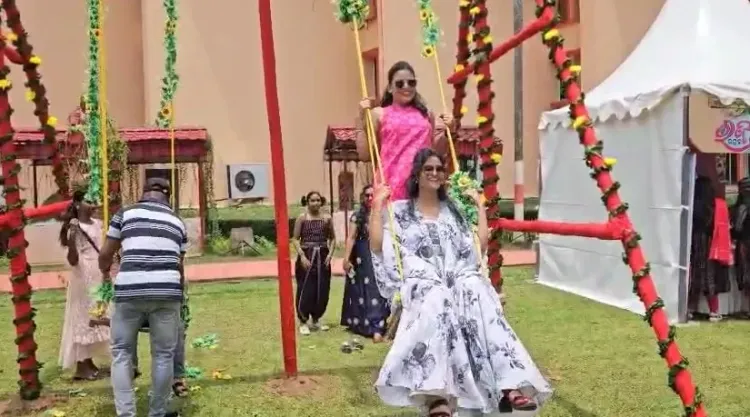What Makes the Raja Festival a Vibrant Celebration of Womanhood and Odia Heritage?

Synopsis
Experience the vibrant Raja Festival in Odisha, where the celebration of womanhood and nature comes alive with joy and tradition. Discover how this unique festival honors the sacred connection between women and the Earth, inviting everyone to partake in its colorful festivities. Join us in exploring a cultural legacy that fosters community and respect for life’s cycles.
Key Takeaways
- Raja Festival celebrates the sacred connection between women and the Earth.
- It honors menstruation as a symbol of fertility and life.
- Unmarried girls are central to the festivities, enjoying a break from daily chores.
- Community bonding is emphasized through shared cooking and celebrations.
- The festival promotes respect for nature and the cyclical rhythms of life.
Bhubaneswar, June 14 (NationPress) As dawn breaks in Odisha, the atmosphere is filled with joyful laughter, lively folk melodies, and the delightful sight of young girls gracefully swinging on beautifully decorated wooden swings. With hands embellished in mehendi, feet adorned with vibrant alta, and spirits soaring with happiness, the state embraces one of its most beloved festivals – Raja Parba.
The festivities kick off this Saturday with Pahili Raja, a three-day event that celebrates womanhood, fertility, and the sacred bond between women and the Earth.
Deeply rooted in Odia culture, the Raja Festival (pronounced raw-jaw) is a remarkable and progressive tradition that honors menstruation as a symbol of fertility and creation, reflecting both women's essence and nature's cycle. The term "Raja" originates from "Rajaswala," which signifies a woman experiencing her menstrual phase. It is believed that during this period, Mother Earth, or Basumati, undergoes her own cycle and merits a break from agricultural work. As a mark of respect, all ploughing and tilling come to a halt.
The festival unfolds across three days – Pahili Raja (the initial day), Raja Sankranti (the second and most auspicious day), and Sesha Raja or Bhuin Dahana (the final day). A symbolic “Basumati Snana”, or cleansing of the Earth, occurs on the fourth day, symbolizing the end of the celebrations.
Women, particularly unmarried girls, are at the core of this celebration. Freed from everyday responsibilities, they are invited to relax, don their finest sarees, and revel in their femininity. Homes sparkle with colorful rangolis, and swings are hung from mango and banyan trees. The air fills with songs of joy as girls sing Raja geet, share laughter, and engage in traditional games.
The culinary treasures of Raja hold equal importance. Kitchens resonate with the delightful scent of poda pitha, a scrumptious rice cake prepared with rice flour, jaggery, coconut, and ghee, cooked slowly in earthen ovens. Women gather in groups to whip up large quantities, sharing stories and laughter while distributing food to neighbors – a beautiful representation of community spirit.
Traditions also suggest that girls avoid walking barefoot, abstain from physical labor, and skip meals after sunset during Raja, as it is believed to preserve physical balance and well-being.
While the festival primarily centers on women, it is a joyous occasion for everyone. Men and boys partake in the merriment, engaging in games like taas (cards), ludo, kabaddi, and savoring home-cooked meals. For many, it serves as a time to return to their roots and relive cherished childhood memories.
Beyond its vibrant colors and customs, the Raja festival conveys a profound message: menstruation is not a taboo but a sacred phenomenon. It celebrates the cyclical nature of life, encourages rest and respect for both women and the Earth, and gently reminds us to coexist harmoniously with nature.






